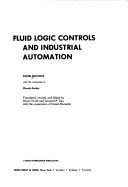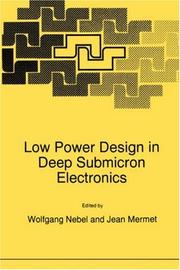| Listing 1 - 5 of 5 |
Sort by
|

ISBN: 0471091723 Year: 1973 Publisher: New York (N.Y.): Wiley
Abstract | Keywords | Export | Availability | Bookmark
 Loading...
Loading...Choose an application
- Reference Manager
- EndNote
- RefWorks (Direct export to RefWorks)
Automatic control --- Fluid logic --- Fluidic devices --- #KVIV --- Fluid power technology --- Fluidic logic --- Pneumatic logic --- Fluid mechanics --- Control engineering --- Control equipment --- Control theory --- Engineering instruments --- Automation --- Programmable controllers --- Automatic control. --- Fluid logic. --- Fluidic devices. --- Fluidics. --- Fluidics
Book
ISBN: 1789841763 1789841755 1838819398 Year: 2019 Publisher: IntechOpen
Abstract | Keywords | Export | Availability | Bookmark
 Loading...
Loading...Choose an application
- Reference Manager
- EndNote
- RefWorks (Direct export to RefWorks)
Fluidics, an increasingly examined topic in nanoscience and nanotechnology is often discussed with regard to the handling of fluid flow, material processing, and material synthesis in innovative devices ranging from the macroscale to the nanoscale. Nanoemulsions - Properties, Fabrications and Applications reviews key concepts in nanoscale fluid mechanics, its corresponding properties, as well as the latest trends in nanofluidics applications. With attention to the fundamentals as well as advanced applications of fluidics, this book imparts a solid knowledge base and develops skill for future problem-solving and system analysis. This is a vital resource for upper-level engineering students who want to expand their potential career opportunities and familiarize themselves with an increasingly important field.
Fluidics. --- Fluid logic --- Fluidic logic --- Pneumatic logic --- Automatic control --- Fluid mechanics --- Physical Sciences --- Engineering and Technology --- Chemistry --- Physical Chemistry --- Nanochemistry

ISBN: 079234569X 9780792345695 Year: 1997 Volume: 337
Abstract | Keywords | Export | Availability | Bookmark
 Loading...
Loading...Choose an application
- Reference Manager
- EndNote
- RefWorks (Direct export to RefWorks)
Metal oxide semiconductors, Complementary --- Low voltage integrated circuits --- Microprocessors --- Design and construction --- Metal oxide semiconductors [Complementary ] --- Congresses --- Fluid logic --- Metal oxide semiconductors, Complementary - Design and construction --- Low voltage integrated circuits - Design and construction --- Microprocessors - Design and construction
Book
ISBN: 9811680787 9811680779 Year: 2023 Publisher: Singapore : Springer Nature Singapore : Imprint: Springer,
Abstract | Keywords | Export | Availability | Bookmark
 Loading...
Loading...Choose an application
- Reference Manager
- EndNote
- RefWorks (Direct export to RefWorks)
This textbook is intended as a core text for courses on aeroelasticity or aero-elasto-mechanics for senior undergraduate/graduate programs in aerospace and mechanical engineering. The book focuses on the basic understanding of the concepts required in learning about aeroelasticity, from observation, reasoning, and understanding fundamental physical principles. Fundamental and simple mathematics will be introduced to describe the features of aeroelastic problems, and to devise simple concurrent physical and mathematical modeling. It will be accompanied by the introduction and understandings of the mechanisms that create the interactions that generate the aeroelastic phenomena considered. The students will also be led to the relation between observed phenomena, assumptions that may have to be adopted to arrive at physical and mathematical modelling, interpreting and verifying the results, and the accompanied limitations, uncertainties and inaccuracies. The students will also be introduced to combine engineering problem solving attitude and determination with simple mechanics problem-solving skills that coexist harmoniously with a useful mechanical intuition.
Fluid mechanics. --- Aerospace engineering. --- Astronautics. --- Materials. --- Fluidics. --- Engineering Fluid Dynamics. --- Aerospace Technology and Astronautics. --- Fluid logic --- Fluidic logic --- Pneumatic logic --- Automatic control --- Fluid mechanics --- Engineering --- Engineering materials --- Industrial materials --- Engineering design --- Manufacturing processes --- Space sciences --- Aeronautics --- Astrodynamics --- Space flight --- Space vehicles --- Aeronautical engineering --- Astronautics --- Hydromechanics --- Continuum mechanics --- Materials --- Aeroelasticity.
Book
ISBN: 3319732609 3319732595 Year: 2018 Publisher: Cham : Springer International Publishing : Imprint: Springer,
Abstract | Keywords | Export | Availability | Bookmark
 Loading...
Loading...Choose an application
- Reference Manager
- EndNote
- RefWorks (Direct export to RefWorks)
This book provides the first comprehensive state-of-the-art research on tree (dendritic) fluid flow and heat transfer. It covers theory, numerical simulations and applications. It can serve as extra reading for graduate-level courses in engineering and biotechnology. Tree flow networks, also known as dendritic flow networks, are ubiquitous in nature and engineering applications. Tree-shaped design is prevalent when the tendency of the flow (fluid, energy, matter and information) is to move more easily between a volume (or area) and a point, and vice versa. From the geophysical trees to animals and plants, we can observe numerous systems that exhibit tree architectures: river basins and deltas, lungs, circulatory systems, kidneys, vascularized tissues, roots, stems, and leaves, among others.Tree design is also prevalent in man-made flow systems, both in macro- and microfluidic devices. A vast array of tree-shaped design is available and still emerging in chemical engineering, electronics cooling, bioengineering, chemical and bioreactors, lab-on-a-chip systems, and smart materials with volumetric functionalities, such as self-healing and self-cooling. This book also addresses the basic design patterns and solutions for cooling bodies where there is heat generation. Several shapes of fin as well as assemblies of fins are addressed. An up-to-date review of cavities, i.e., inverted or negative fins, for facilitating the flow of heat is also presented. Heat trees using high thermal conductivity material can be used in the cooling of heat-generating bodies, and can also be applied to the cooling of electronics.
Fluidics. --- Engineering. --- Energy systems. --- Energy storage. --- Biomedical engineering. --- Engineering design. --- Civil engineering. --- Engineering Design. --- Energy Storage. --- Biomedical Engineering/Biotechnology. --- Civil Engineering. --- Biomedical Engineering. --- Energy Systems. --- Fluid logic --- Fluidic logic --- Pneumatic logic --- Automatic control --- Fluid mechanics --- Biomedical Engineering and Bioengineering. --- Engineering --- Public works --- Clinical engineering --- Medical engineering --- Bioengineering --- Biophysics --- Medicine --- Design, Engineering --- Industrial design --- Strains and stresses --- Design --- Storage of energy --- Force and energy --- Power (Mechanics) --- Flywheels --- Pulsed power systems
| Listing 1 - 5 of 5 |
Sort by
|

 Search
Search Feedback
Feedback About UniCat
About UniCat  Help
Help News
News